Macro Musing: The Election - five key themes to watch

Designing an intelligent and scalable retirement income solution
Part 1: The role for protection strategies in balancing flexibility with capital protection.
After anxiously waiting around the starting gate for several weeks, the pollies are now off and racing, with the Federal Election finally called for Saturday, 3 May. In what could be a photo finish, here are five key themes to keep an eye on.
1. Polls indicate the election is very close
While polls indicate the Coalition has a lead in primary voting intentions, on a two-party preferred basis Labor and the Coalition have been neck and neck (Figure 1, Figure 2). Some recent polls, such as the Roy Morgan survey, suggest Labor's prospects have improved into the final stretch, but individual polls have a small sample and can be volatile. While polls indicate the election is close, the following themes show just how uncertain the outcome remains.
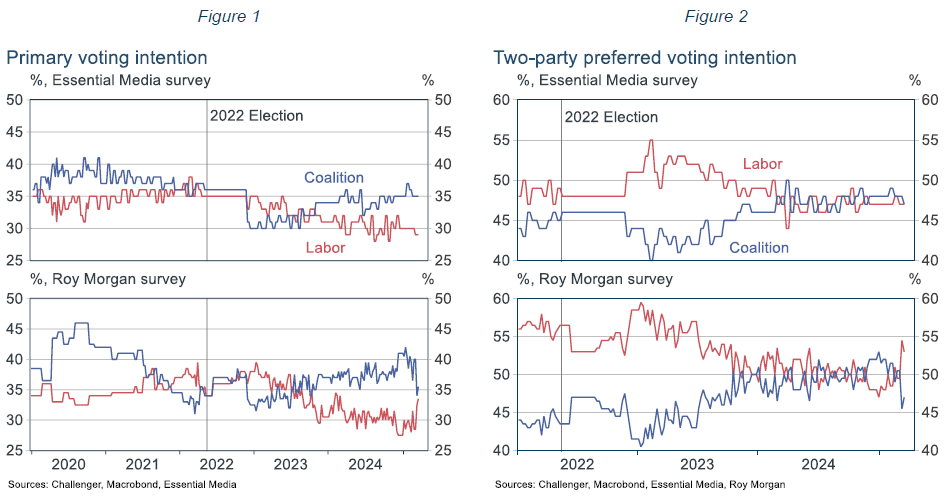
2. Declining major parties' vote share makes minority Government likely
As close as the two-party preferred vote is, since the mid-1980s the combined primary vote of Labor and the Coalition has been declining, making the outcome more uncertain. While the major parties combined primary vote exceeded 90% until the mid-1980s, it has declined significantly since then to be just 68% at the 2022 Federal election, the lowest on record (Figure 3).
For many years the declining primary vote share was masked by preferences from minor parties and independents flowing to the Coalition and Labor ensuring the major parties accounted for almost all elected members of the House of Representatives. But eventually their declining primary vote was bound to result in more non-Labor and non-Coalition members of parliament.
The 2022 election was a watershed with 10 independent candidates elected to the House, up from three at the 2019 election. In addition, there were four Greens members elected, and two single members for other parties (one each for Centre Alliance and Katter's Australian Party). This was the most independent candidates ever. Seven of these independents were 'Teal' candidates. Three Coalition members have resigned from their party during this Parliament to sit on the cross bench, meaning a record 13 independents and six other non-major party candidates are facing re-election (Figure 4).
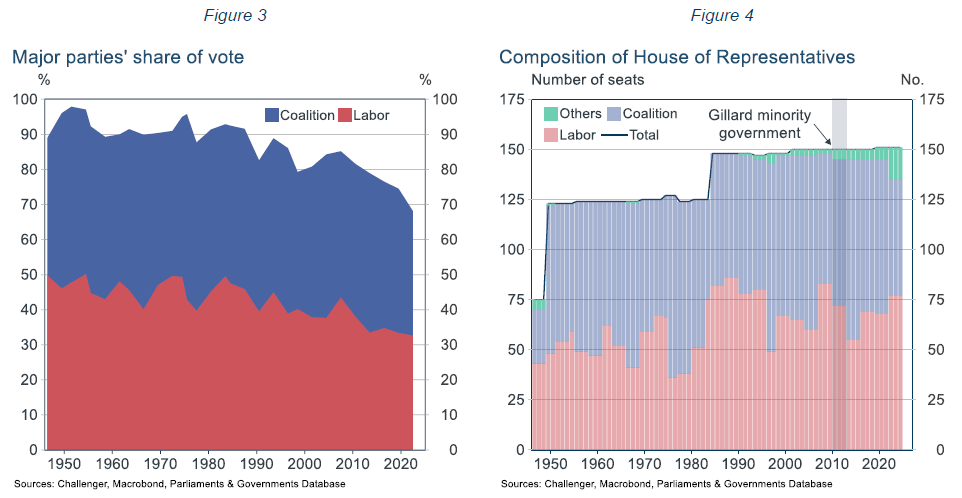
The rise of the Teals at the 2022 election reflected the ongoing declining primary vote of the major parties. More ecent factors also contributing to the support for Teal candidates, notably climate change and the under representation of women in Parliament, were not seen to be addressed by the Liberal Party. These remain pertinent today suggesting that the underlying support for Teal candidates won't abate significantly. Notably, first term independents have historically been re-elected given their higher profile than when they first stood, suggesting it is likely that many of the independents will be re-elected.
With a greater share of independent members, it becomes much harder for either party to get the 76 seats needed to form a majority Government (the number of seats at this election reduces to 150 from 151 at the 2022 election, with one seat abolished in each of NSW and Victoria, and a new seat in Western Australia). In 2010, Labor formed a minority Government under Julia Gillard, but there were only five independents. With ten or more likely to be elected at this election, and two-party preferences neck and neck, the odds of either party forming a majority Government are very low.
3. Not all swings are equal
National polls report the likely swing toward or away from the Government. But votes in each electorate matter, not the national vote. And there tends to be a wide dispersion in the swing across electorates. How wide that dispersion is matters greatly. In 2022, the swing against the Government was 3.9%, almost identical to the 3.7% swing against the Government in 2013. But in 2022 there were many seats with a large swing, both toward and away from the Government (Figure 5).
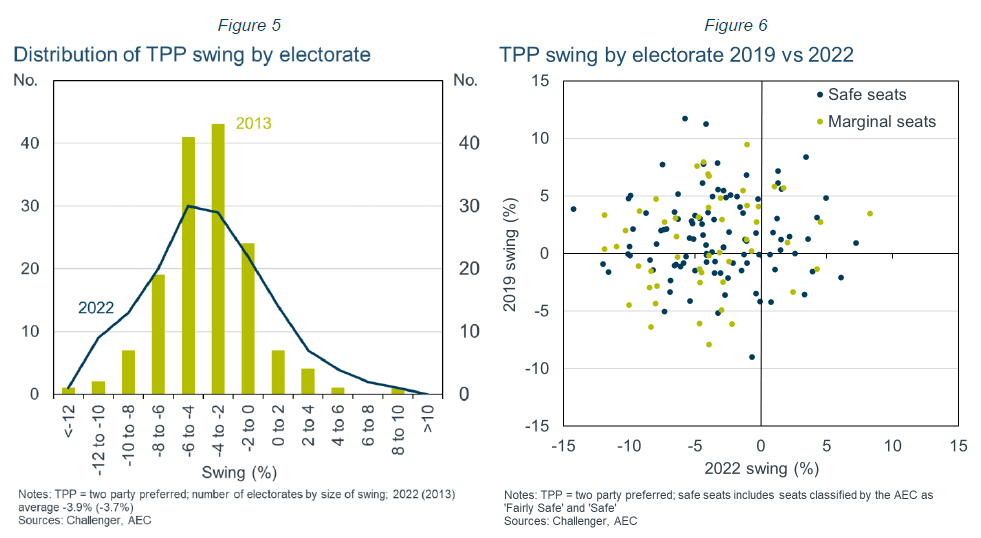
Despite the similar national swing at these two elections, the Coalition Government lost more seats at 2022 election (19) where there was a wider dispersion of the swing across electorates, than the Labor Government lost in 2013. However, of course the larger number of seats lost by the previous Government in 2022 did not benefit the Opposition to the same extent in 2022 given the rise of the independents, with Labor picking up just nine in contrast to the 17 picked up by the Coalition in 2013.
You might think that if a seat has swung one way at a given election it would be more likely to swing back the other way at the next election. But this has not been the case (Figure 6). The relationship between the swing at consecutive elections has been effectively random for both marginal and safe seats.
4. Increased early voting changes the dynamics of campaigning
The share of votes cast before election day has been increasing sharply at recent Federal elections. Given the recent trajectory, it wouldn’t be surprising to see more than half of votes cast before election day. While postal votes have grown steadily, most of the increase has come from pre-poll votes- those cast at a booth before election day (Figure 7). This trend means politicians are announcing policies earlier in the campaign, leaving very little to the final days.
Interestingly, across almost all electorates, both marginal and safe, at the 2022 election the Coalition received a larger share for many early votes (postal votes and some types of pre-poll votes) (Figure 8).
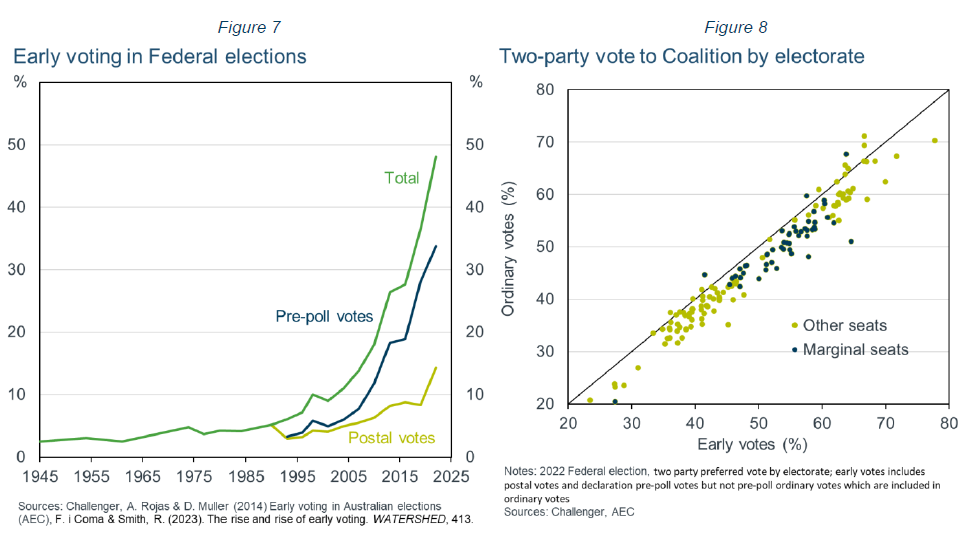
5. Declining voter turnout adds a new dynamic
Australians are become less engaged in Federal elections. The 2022 election saw the lowest turnout since voting was made compulsory a century ago (Figure 9). We may soon see the parties make electoral pitches designed not only to attract voters, but to get their voters to turn out on election day. This occurs in the United States, where such appeals typically lean away from the political centre.
In addition, close to 6% of votes in the latest Federal election were informal (invalid) (Figure 10). However, the share of informal votes is not related to turnout by electorate, or whether the seat is marginal or safe. It seems random. This introduces another element of noise to outcomes in each electorate.
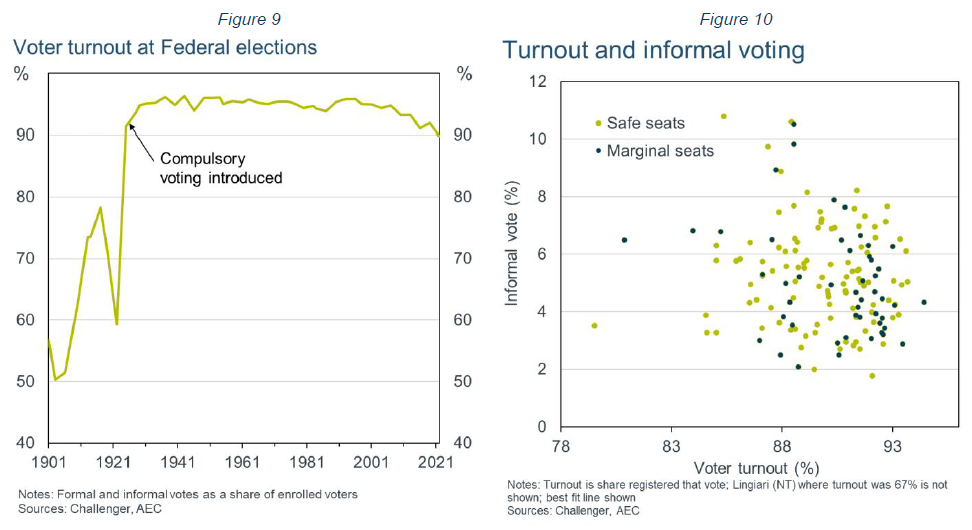
Key takeaways
With the redistribution (one more seat in WA, one less in each of NSW and Victoria) the Labor Government notionally has 77 seats. If it loses just three seats, fewer than most Governments lose after their first term, it will lose its majority. The Coalition notionally has 58 seats, meaning it needs to pick up 18 seats, a very big ask, to get a majority. With higher profile that incumbent independents have, many are likely to be re-elected. Almost certainly we'll see a hung Parliament with a minority Government.
With many independents and minor parties, the number and importance of seats that are not a race between the Coalition and Labor, reduces the significance of national polls reporting the two-party preferred split. Swings can vary widely by electorate and so polls are unlikely to be a good guide to which side will get the most seats, and have the best chance to form a minority Government.
A better guide is likely to be the views of informed analysts who consider outcomes seat by seat. Betting markets are also worth watching. These were a better predictor than polls of the outcome of the US election. While critics deride betting markets as little more than a bunch of blokes at the pub, they are putting money on the line in contrast to respondents to polls, and punters may consider the roll of non-major party candidates. For what it’s worth, just after the election was called, betting markets had Labor ahead at around $1.75, compared to around $2.00 for the Coalition.
